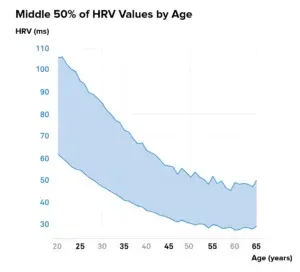Topics
- Article
- HRV
What is a Good HRV? It Varies for Everyone

Heart rate variability is a highly individualized metric. We break down averages by age and what it means for you.
What is a Good Heart Rate Variability?
Heart rate variability (HRV) is a measure of your autonomic nervous system that can be extremely useful for evaluating your physical fitness and determining how ready your body is to perform. If you’re new to the subject of heart rate variability and would like to learn more about what it is and why it’s such a valuable tool, check out our Ultimate Guide to HRV. Generally speaking, higher heart rate variability is a sign of better fitness. But, the most important thing to know with HRV is that it is an incredibly personalized metric that differs greatly from one individual to the next. When attempting to figure out what is a good heart rate variability for you, a number of factors such as age, gender, fitness level, lifestyle, environment and genetics must be taken into account.
What Do HRV Numbers Mean?
Heart rate variability is the difference in time between the beats of your heart, measured in milliseconds (ms). For the most part, younger people have higher HRV than older people, and males may have slightly higher HRV than females. Additionally, elite athletes (endurance athletes in particular) tend to have greater heart rate variability than non-athletes. However, what represents a healthy HRV varies for everybody. There are many exceptionally fit people who have heart rate variability that is lower than the norm. Below is a graphic that shows the average range of heart rate variability by age, from 20-65.
Heart Rate Variability Chart

You can see quite clearly that HRV declines as people get older. The middle 50% of 20-25 year olds usually fall in the 55-105 range, while 60-65 year olds are normally between 25-45.
“What is a Good HRV Score for Me?”
The average heart rate variability for all WHOOP members is 65 for men and 62 for women. For 25-year-olds it’s 78, for 35-year-olds it’s 60, for 45-year-olds it’s 48, and for 55-year-olds it’s 44. In general, people using WHOOP tend to be athletes and/or health-conscious individuals looking to perform better at whatever they do. If your HRV falls in line with the WHOOP averages, it's reasonable to consider it “good.” However, rather than comparing yourself to others and worrying about what is good or normal, it’s much more practical to follow your own HRV trends. If you’re making efforts to better your overall health and fitness, over time you should see your heart rate variability begin to rise. On the other hand, a downward trend in HRV can be a sign that you’re overtraining or engaging in other unhealthy behaviors, like poor nutrition or insufficient sleep.
Monitor and Improve Your Heart Rate Variability with WHOOP
HRV is a very sensitive metric that changes drastically throughout the day, and from one day to the next. Tracking it continuously, or at any time when you’re active, is not useful because it fluctuates so significantly. Even changes in your breathing during sleep affect it. To get a reliable measurement, WHOOP calculates your heart rate variability during your deepest period of sleep each night. This gives you an accurate understanding of your baseline so that you can better monitor your HRV trends. Heart rate variability is a key component to your daily WHOOP recovery--basically a readiness score for how prepared your body is to perform. WHOOP also quantifies the strain you take on each day and lets you know how hard to work out in order to meet your fitness goals, which in turn will help improve your HRV. In fact, we found that after 4 months on WHOOP, collegiate athletes’ heart rate variability increased by an average of 8.3 milliseconds. Learn More: Normal Heart Rate Variability (Average HRV Range by Age and Gender)